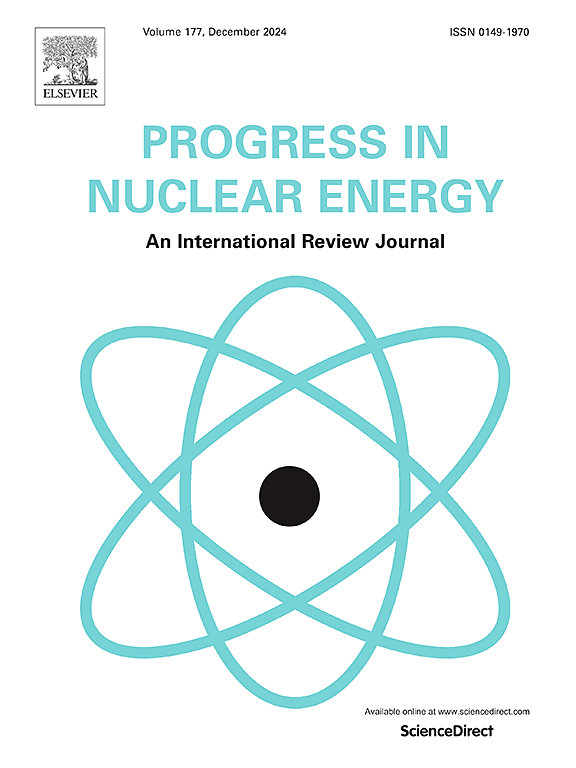基于机器学习的水冷smr噪声诊断:二维系统的原理证明
IF 3.2
3区 工程技术
Q1 NUCLEAR SCIENCE & TECHNOLOGY
引用次数: 0
摘要
本研究探索了一种利用中子噪声分析和机器学习(ML)方法对二维小型模块化反应堆(smr)进行堆芯监测的方法。在频域模拟变强度(AVS)扰动吸收器,分析了大型反应堆和小型反应堆的噪声特性差异。结果表明,smr具有较强的点动力学特征,使微扰诊断复杂化。发现热群中子噪声比快群中子噪声携带更多的诊断信息。这使得热群中子噪声对局部扰动更有效。卷积神经网络(CNN)在每个样本只包含一个或两个AVS源的数据集上进行训练。尽管训练数据集有限,但该模型可以准确地定位样本中多达10个源。结果表明,该模型具有较强的泛化能力和较高的节点精度。为了解决稀疏检测器场景,设计了一个两阶段的管道,在源定位之前从有限的数据点重建整个反应堆噪声场。该管道具有50%的检测器覆盖率,可以有效地重建和定位,准确地捕获全局和局部噪声分量。对于减少11%、6%和3%覆盖率的仪器场景,该模型保持了合理的性能,基于接近度的度量表明了强大的定位能力。研究结果强调了探测器放置策略的重要性,以平衡全局和局部噪声分量,从而实现有效的异常检测。研究表明,即使在有限的数据可用性下,机器学习技术也可以增强中子噪声分析。这项工作有助于提高smr的安全性和运行可靠性,强调先进的监测方法和数据知情的仪器布局对优化性能、安全性和效率的重要性。本文章由计算机程序翻译,如有差异,请以英文原文为准。
Machine learning-based noise diagnostics for water-cooled SMRs: proof of principle on 2-dimensional systems
This study explores a core monitoring approach for two-dimensional Small Modular Reactors (SMRs) using neutron noise analysis and machine learning (ML) methods. Absorber of Variable Strength (AVS) perturbations are simulated in the frequency domain to analyze reactor noise behavior differences between large reactors and SMRs. It is demonstrated that SMRs exhibit stronger point-kinetic characteristics, complicating perturbation diagnosis. Thermal-group neutron noise is found to carry more diagnostic information than fast-group neutron noise. This makes thermal-group neutron noise more effective for localizing perturbations. A convolutional neural network (CNN) is trained on a dataset that contains only one or two AVS sources per sample. Despite this limited training dataset, the model can accurately localize up to 10 sources in a sample. The results demonstrate the model's strong generalization capability and high nodal accuracy. To address sparse detector scenarios, a two-stage pipeline is designed to reconstruct full reactor noise fields from limited data points prior to source localization. The pipeline demonstrates effective reconstruction and localization with 50 % detector coverage, accurately capturing both global and local noise components. For reduced instrumentation scenarios of 11 %, 6 %, and 3 % coverage, the model retains reasonable performance, with proximity-based metrics indicating robust localization capabilities. The results highlight the importance of strategic detector placement to balance global and local noise components for effective anomaly detection. The research demonstrates that ML techniques can enhance neutron noise analysis, even under limited data availability. This work contributes to enhancing the safety and operational reliability of SMRs, emphasizing the importance of advanced monitoring methods and data-informed instrumentation layouts to optimize performance, safety, and efficiency.
求助全文
通过发布文献求助,成功后即可免费获取论文全文。
去求助
来源期刊

Progress in Nuclear Energy
工程技术-核科学技术
CiteScore
5.30
自引率
14.80%
发文量
331
审稿时长
3.5 months
期刊介绍:
Progress in Nuclear Energy is an international review journal covering all aspects of nuclear science and engineering. In keeping with the maturity of nuclear power, articles on safety, siting and environmental problems are encouraged, as are those associated with economics and fuel management. However, basic physics and engineering will remain an important aspect of the editorial policy. Articles published are either of a review nature or present new material in more depth. They are aimed at researchers and technically-oriented managers working in the nuclear energy field.
Please note the following:
1) PNE seeks high quality research papers which are medium to long in length. Short research papers should be submitted to the journal Annals in Nuclear Energy.
2) PNE reserves the right to reject papers which are based solely on routine application of computer codes used to produce reactor designs or explain existing reactor phenomena. Such papers, although worthy, are best left as laboratory reports whereas Progress in Nuclear Energy seeks papers of originality, which are archival in nature, in the fields of mathematical and experimental nuclear technology, including fission, fusion (blanket physics, radiation damage), safety, materials aspects, economics, etc.
3) Review papers, which may occasionally be invited, are particularly sought by the journal in these fields.
 求助内容:
求助内容: 应助结果提醒方式:
应助结果提醒方式:


